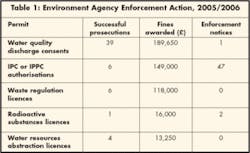Risk-Based Regulation of Discharges - Whose Risk is It Anyway?
UK industry council responds to Water Quality Discharge Consents under Environment Agency’s new Operator & Pollution Risk Appraisal (OPRA) scheme.
In the United Kingdom, the Environment Agency (EA) is proposing to revise its method of regulating discharges to the water environment using risk-based principles known as the Hampton Principles. To this end, the EA Operator and Pollution Risk Appraisal system (OPRA), which has already been applied to other regulatory regimes such as Pollution Prevention and Control and Waste Management, is now being adapted by the agency for the water quality regime.
Motivation to implement such changes comes from legislative drivers such as the Legislative and Regulatory Reform Bill, Water Framework Directive and basic economic drivers to improve efficiency and demonstrate value for money to the taxpayer. The agency went out to public consultation on its proposals for regulating discharges earlier this year and plans to repeat the exercise this summer based on responses received.
The Environmental Industries Commission’s (EIC’s) Water Pollution Control Working Group represents over 80 companies supplying water pollution control technologies and services. It’s lobbying for the EA to consider not only its method of regulating discharges but also the fundamental nature of what’s being regulated.
What’s at Stake?
Whilst the EIC is broadly supportive of the agency’s proposals, there are a number of issues that should give cause for concern. These include: (i) use of prescriptive conditions to trigger risk assessment in the first place; (ii) continued use of upper bound limits on flow rate and concentration within discharge consents and the impact this may have on water efficiency; and (iii) the impact of the new water quality regime on efforts to clean up existing water contamination as part of brownfield regeneration projects.
If the new regulatory regime creates liabilities that discourage operators from delivering environmental improvements then an opportunity to deliver real benefits to the environment will have been missed and responsibility for such will rest with the EA.
Triggering Risk Assessment
As currently formulated, a discharge rate of 50 m3/day is a critical factor within the system for determining whether a site is viewed as a higher risk (Full OPRA) site or lower risk (Simplified OPRA) site. Above this limit, a continuous discharge would be subject to Full OPRA assessment unless it’s cooling water, a discharge of surface water from a quarry or mineral extraction, a discharge with no numerical limits or numerical limits only for BOD and/or SS and/or oils/grease and/or temperature and/or pH.
Whilst this may work for many “typical” sewage treatment works discharges, there are other factors to consider that may result in a site being unnecessarily classified as Full OPRA (e.g., treated effluent from a leachate treatment plant to a large body of non-sensitive water where an ammonia limit is also included) or a site being classified as Simplified OPRA when perhaps it should not (e.g., large effluent treatment plant from a food manufacturing facility with only BOD, SS and pH limits but where the BOD load discharged is approaching the maximum assimilative capacity of the receiving watercourse).
EIC’s view is the only way to effectively judge the risk or effect of pollutants in a discharge is to consider the mass emission of that pollutant and assimilation capacity (with no detrimental effect) of the receiving environment. Using a numerical limit on flow rate as the principal tool to judge whether a discharge should be in one category of OPRA or not seems an inaccurate and empirical classification procedure.
It’s also unclear how discharge consents for large construction sites would be handled. The discharge from water management schemes on such sites may well exceed 50 m3/day yet the constituents of such are often routine and not in our view worthy of detailed risk assessment (which may, for example, encumber a developer’s reasonable efforts to improve brownfield sites).
Mass Emission Based Consents
From an operational perspective, high concentrations of pollutants at low flow rates or low concentrations at high flow rates will pose a much lower risk to the environment than the upper bound limits on both flow rate and concentration that characterises the agency’s traditional approach to regulating discharges and which is only really appropriate for discharges that are more-or-less constant in volume and have little variation in composition or mass of pollutant emitted.
Apart from the doubt about how these values are calculated and set in the first place, the problem with this approach is that, with the drive for reduced water consumption (which is now embodied in regulation through the IPPC), the concentration of pollutants may well increase in a much reduced flow, even though the total mass of pollutant emitted into the receiving environment remains the same, or even decreases. Since non-compliance with consents is nearly always decided on the basis of an infringement of the concentration limit (irrespective of flow) or maximum flow (irrespective of pollutant concentration), cases where the concentration limit has been exceeded and yet the mass emission of a pollutant has significantly reduced (as the flow is much lower) are ever more common.
With increasing pressures on business to reduce water use on site (especially in the south of England where water resources are very limited) the current approach risks penalising operators for achieving reductions in water use that result in increased constituent concentrations above their discharge consent limits.
To continue to use concentrations as the main monitored parameter and logically take into account reduced effluent flows, any particular site would have to be continually renegotiating its consent. This would be both difficult to do and place an unacceptable regulatory burden on the EA. If a mass emission based consent were to be adopted, there would be better monitoring of environmental emissions with a sounder scientific basis and removal of an artificial barrier to water use reduction.
The EA’s proposed change to this OPRA method of regulation is, in the EIC’s opinion, precisely the right time to start to move to mass-emission based consents as it’s an inherently risk-based approach.
Brownfield Regeneration Impact
Whilst discharges from groundwater remediation schemes are undoubtedly a small proportion of the agency’s regulatory activity in relation to discharges, when such works arise in relation to brownfield regeneration they do so from a desire to improve the environment, remove historic legacies from previous land use and bring derelict land back into use.
In this context, the EIC is concerned treatment processes that are routine from a groundwater and brownfield regeneration perspective may attract a very high OPRA score (due to the relatively complex systems involved) without due regard to the fact the pollution is already in the environment nor to the wider environmental benefit of bringing previously used land back into use.
Much good work has been done by the EA and others in removing barriers to brownfield regeneration and it would be regrettable if the agency’s latest proposals in relation to risk based regulation of discharges were to create a new barrier in this area. Where planning policy supports the related development, a presumption in favour of issuing a discharge consent, with appropriate qualifications, is perhaps one way forward.
Authors’ Notes:
Duncan Russell, of WSP Environmental, and Richard Barnard, of Hyder Consulting, are members of the Water Pollution Control Working Group of the London-based Environmental Industries Commission. EIC was launched in 1995 to give the UK environmental technology and services (ETS) industry a voice with government. With over 320 member companies, it has grown to be the largest trade association in Europe for this industry. Contact: [email protected] or www.eic-uk.co.uk


